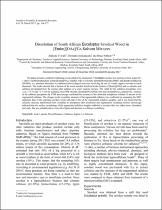 ResearchSpace
ResearchSpace
Dissolution of South African Eucalyptus sawdust wood in [Emim][OAc]/Co-solvent mixtures
JavaScript is disabled for your browser. Some features of this site may not work without it.
- ResearchSpace
- →
- Research Publications/Outputs
- →
- Journal Articles
- →
- View Item
| dc.contributor.author |
Tywabi, Zikhona

|
|
| dc.contributor.author |
Deenadayalu, Nirmala

|
|
| dc.contributor.author |
Sithole, Bishop B

|
|
| dc.date.accessioned | 2017-11-02T13:05:44Z | |
| dc.date.available | 2017-11-02T13:05:44Z | |
| dc.date.issued | 2017-03 | |
| dc.identifier.citation | Tywabi, Z., Deenadayalu, N. and Sithole, B.B. 2017. Dissolution of South African Eucalyptus sawdust wood in [Emim][OAc]/Co-solvent mixtures. Journal of Scientific & Industrial Research, vol. 76(3): 166-172. | en_US |
| dc.identifier.issn | 0022-4456 | |
| dc.identifier.uri | http://nopr.niscair.res.in/handle/123456789/40647 | |
| dc.identifier.uri | http://nopr.niscair.res.in/bitstream/123456789/40647/1/JSIR%2076%283%29%20166-172.pdf | |
| dc.identifier.uri | http://hdl.handle.net/10204/9713 | |
| dc.description | Article published in Journal of Scientific & Industrial Research, vol. 76(3): 166-172 | en_US |
| dc.description.abstract | The paper presents a method of obtaining wood cellulose by dissolution of eucalyptus sawdust in a mixture of ionic liquid (IL) 1-ethyl-3-methylimidazolium acetate [Emim][OAc] together with co-solvents; dimethylformamide (DMF) and dimethylsulphoxide (DMSO), as a potential alternative to traditional non-ecological processes involving the use of volatile organic solvents or harsh chemicals. The results showed that a fraction of the wood sawdust dissolved in the mixture of [Emim][OAc] and co-solvents, and cellulose precipitated from the mixture after addition of a water /acetone mixture. The yields for the cellulose precipitates were 32.5, 17.8 % and 7.2 % for the [Emim][OAc]/DMF mixture, [Emim][OAc]/DMSO and neat [Emim][OAc], respectively. Analysis of the cellulose precipitates by FTIR spectroscopy confirmed the presence of the dominant amorphous cellulose II anomer in the regenerated cellulose. The changes in the crystalline structure of the regenerated cellulose was confirmed by comparing the XRD analytical data of the untreated sawdust wood with that of the of the regenerated cellulose samples: and it was found that the cellulose structure transformed from crystalline to amorphous after dissolution and regeneration. Scanning electron microscopy indicated that the surface morphology of the regenerated cellulose samples exhibited a structure that was rather loose, disordered and curly: this was probably due to removal of lignin and decrease in cellulose crystallinity. | en_US |
| dc.language.iso | en | en_US |
| dc.publisher | NATL INST SCIENCE COMMUNICATION-NISCAIR | en_US |
| dc.relation.ispartofseries | Worklist;19725 | |
| dc.subject | Ionic liquids | en_US |
| dc.subject | Wood biomass | en_US |
| dc.subject | Cellulose | en_US |
| dc.subject | Lignin | en_US |
| dc.subject | Co-solvents | en_US |
| dc.title | Dissolution of South African Eucalyptus sawdust wood in [Emim][OAc]/Co-solvent mixtures | en_US |
| dc.type | Article | en_US |
| dc.identifier.apacitation | Tywabi, Z., Deenadayalu, N., & Sithole, B. B. (2017). Dissolution of South African Eucalyptus sawdust wood in [Emim][OAc]/Co-solvent mixtures. http://hdl.handle.net/10204/9713 | en_ZA |
| dc.identifier.chicagocitation | Tywabi, Zikhona, Nirmala Deenadayalu, and Bishop B Sithole "Dissolution of South African Eucalyptus sawdust wood in [Emim][OAc]/Co-solvent mixtures." (2017) http://hdl.handle.net/10204/9713 | en_ZA |
| dc.identifier.vancouvercitation | Tywabi Z, Deenadayalu N, Sithole BB. Dissolution of South African Eucalyptus sawdust wood in [Emim][OAc]/Co-solvent mixtures. 2017; http://hdl.handle.net/10204/9713. | en_ZA |
| dc.identifier.ris | TY - Article AU - Tywabi, Zikhona AU - Deenadayalu, Nirmala AU - Sithole, Bishop B AB - The paper presents a method of obtaining wood cellulose by dissolution of eucalyptus sawdust in a mixture of ionic liquid (IL) 1-ethyl-3-methylimidazolium acetate [Emim][OAc] together with co-solvents; dimethylformamide (DMF) and dimethylsulphoxide (DMSO), as a potential alternative to traditional non-ecological processes involving the use of volatile organic solvents or harsh chemicals. The results showed that a fraction of the wood sawdust dissolved in the mixture of [Emim][OAc] and co-solvents, and cellulose precipitated from the mixture after addition of a water /acetone mixture. The yields for the cellulose precipitates were 32.5, 17.8 % and 7.2 % for the [Emim][OAc]/DMF mixture, [Emim][OAc]/DMSO and neat [Emim][OAc], respectively. Analysis of the cellulose precipitates by FTIR spectroscopy confirmed the presence of the dominant amorphous cellulose II anomer in the regenerated cellulose. The changes in the crystalline structure of the regenerated cellulose was confirmed by comparing the XRD analytical data of the untreated sawdust wood with that of the of the regenerated cellulose samples: and it was found that the cellulose structure transformed from crystalline to amorphous after dissolution and regeneration. Scanning electron microscopy indicated that the surface morphology of the regenerated cellulose samples exhibited a structure that was rather loose, disordered and curly: this was probably due to removal of lignin and decrease in cellulose crystallinity. DA - 2017-03 DB - ResearchSpace DP - CSIR KW - Ionic liquids KW - Wood biomass KW - Cellulose KW - Lignin KW - Co-solvents LK - https://researchspace.csir.co.za PY - 2017 SM - 0022-4456 T1 - Dissolution of South African Eucalyptus sawdust wood in [Emim][OAc]/Co-solvent mixtures TI - Dissolution of South African Eucalyptus sawdust wood in [Emim][OAc]/Co-solvent mixtures UR - http://hdl.handle.net/10204/9713 ER - | en_ZA |





